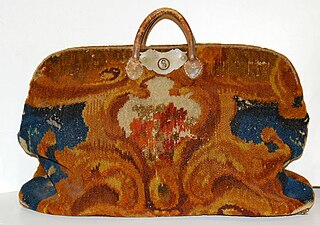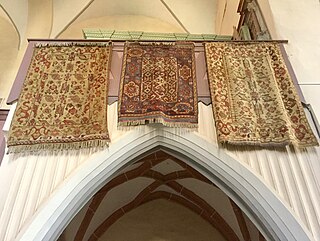
A carpet is a textile floor covering typically consisting of an upper layer of pile attached to a backing. The pile was traditionally made from wool, but since the 20th century synthetic fibers such as polypropylene, nylon, or polyester have often been used, as these fibers are less expensive than wool. The pile usually consists of twisted tufts that are typically heat-treated to maintain their structure. The term carpet is often used in a similar context to the term rug, but rugs are typically considered to be smaller than a room and not attached to the floor.

A Persian carpet or Persian rug, also known as Iranian carpet, is a heavy textile made for a wide variety of utilitarian and symbolic purposes and produced in Iran, for home use, local sale, and export. Carpet weaving is an essential part of Persian culture and Iranian art. Within the group of Oriental rugs produced by the countries of the "rug belt", the Persian carpet stands out by the variety and elaborateness of its manifold designs.

Knot density is a traditional measure for quality of handmade or knotted pile carpets. It refers to the number of knots, or knot count, per unit of surface area - typically either per square inch (kpsi) or per square centimeter (kpsc), but also per decimeter or meter. Number of knots per unit area is directly proportional to the quality of carpet. Density may vary from 25 to 1,000 knots per square inch or higher, where ≤80 kpsi is poor quality, 120 to 330 kpsi is medium to good, and ≥330 kpsi is very good quality. The inverse, knot ratio, is also used to compare characteristics. Knot density = warp×weft while knot ratio = warp/weft. For comparison: 100,000/square meter = 1,000/square decimeter = 65/square inch = 179/gereh.

A prayer rug or prayer mat is a piece of fabric, sometimes a pile carpet, used by Muslims, some Christians, especially in Orthodox Christianity and some Baha'i during prayer.

A carpet bag is a top-opening travelling bag made of carpet, commonly from an oriental rug. It was a popular form of luggage in the United States and Europe in the 19th century, featuring simple handles and only an upper frame, which served as its closure. Some small modern versions are used as handbags or purses.

Uşak carpets, Ushak carpets or Oushak Carpets are Turkish carpets that use a particular family of designs, called by convention after the city of Uşak, Turkey – one of the larger towns in Western Anatolia, which was a major center of rug production from the early days of the Ottoman Empire, into the early 20th century.

The Ardabil Carpet is the name of two different famous Persian carpets, the larger and better-known now in the Victoria and Albert Museum in London. Originally there were two presumably identical carpets, and the London carpet, as restored and reconstructed in the 19th century, uses sections from both. It now measures 34 ft 3 in × 17 ft 6+7⁄8 in. The other carpet, now in the Los Angeles County Museum of Art, and smaller at 23 ft 7 in × 13 ft 1+1⁄2 in, was made up of the sections in adequate condition unused for the London carpet. Both carpets are now smaller than they would have been originally, and there are other fragments in various collections that appear to come from the reconstruction process. The carpets have a typical Tabriz design, with one central medallion and smaller, ornate designs surrounding. Such medallions and shapes were central to the design and reality of Persian gardens, a common symbol of paradise for followers of Islam.
Judy Valentine was an American singer and children's television actress.

The George Washington University Museum and Textile Museum is a museum in Washington, D.C., dedicated to the history of George Washington University and textile arts, located in the Foggy Bottom neighborhood. The museum was founded by collector George Hewitt Myers in 1925 and was originally housed in two historic buildings in D.C.'s Kalorama neighborhood: the Myers family home, designed by John Russell Pope, and an adjacent building designed by Waddy Wood. It reopened in March 2015 as part of George Washington University.
An oriental rug is a heavy textile made for a wide variety of utilitarian and symbolic purposes and produced in "Oriental countries" for home use, local sale, and export.

Bergama Carpet refers to handwoven Turkish carpets, made in the Bergama district in the Izmir Province of northwest Turkey. As a market place for the surrounding villages, the name of Bergama is used as a trade name to define the provenience.

Anatolian rug is a term of convenience, commonly used today to denote rugs and carpets woven in Anatolia and its adjacent regions. Geographically, its area of production can be compared to the territories which were historically dominated by the Ottoman Empire. It denotes a knotted, pile-woven floor or wall covering which is produced for home use, local sale, and export. Together with the flat-woven kilim, Anatolian rugs represent an essential part of the regional culture, which is officially understood as the Culture of Turkey today, and derives from the ethnic, religious and cultural pluralism of one of the most ancient centres of human civilisation.

A. & M. Karagheusian, Inc. was a rug manufacturer headquartered at 295 Fifth Avenue in Manhattan. Manufacturing was located in Freehold Borough, New Jersey and operated for 60 years before closing in 1964. It employed 1,700 people at its peak operation in the 1930s. Bruce Springsteen wrote about the Karagheusian Rug Mill’s closing in his 1984 song "My Hometown".
Arshag Karagheusian was an Armenian rug manufacturer and co-owner of A. & M. Karagheusian, Inc. He also served as the head of the Armenian General Benevolent Union becoming its 4th president from 1943 to 1952, after Boghos Nubar, Calouste Gulbenkian and Zareh Nubar.

Carpets of Middle-Eastern origin, either from Anatolia, Persia, Armenia, Azerbaijan, the Levant, the Mamluk state of Egypt or Northern Africa, were used as decorative features in Western European paintings from the 14th century onwards. More depictions of Oriental carpets in Renaissance painting survive than actual carpets contemporary with these paintings. Few Middle-Eastern carpets produced before the 17th century remain, though the number of these known has increased in recent decades. Therefore, comparative art-historical research has from its onset in the late 19th century relied on carpets represented in datable European paintings.

Caucasian carpets and rugs are primarily made in villages, rather than in cities. They are made from materials particular to individual tribal provinces, the rugs of the Caucasus normally display bold geometric designs in primary colors. Styles typical to the Caucasus region are Daghestan, Verne, Shirvan, Ganja, Kazakh, Karabagh, and Quba rugs. Several carpet styles from contemporary northwestern Iran also fall largely into this bracket, such as the Ardabil rugs.
The Dilmaghani family, the oldest existing manufacturers of hand knotted carpets and oriental rugs, can be traced back to the 1850s Qajar dynasty, Persia. In an industry which largely produces untitled items often identifiable only by experts, the history and lineage of any name relating to specific types of rugs for so many decades is unusual. Through the 1960s, the Dilmaghani family was still designing, manufacturing and importing Persian carpets from Iran to the United States. Dilmaghani is seen as an important connection of 19th and 20th century Persian rug and carpet production in and around the cities of Tabriz and Kermān. Dilmaghani remained as of 1980 among the best known names of branded hand knotted carpets.

The name Transylvanian rug is used as a term of convenience to denote a cultural heritage of 15th–17th century Islamic rugs, mainly of Ottoman origin, which have been preserved in Transylvanian Protestant churches. The corpus of Transylvanian rugs constitutes one of the largest collections of Ottoman Anatolian rugs outside the Islamic world.

The Oriental Carpet Manufacturers (OCM) was a London-based company involved in the production of, and trade with, Oriental carpets. Established in 1907/8 in Istanbul, the company set up and controlled their own carpet manufactures in the central Anatolian region around the town of Konya, and from 1911 onwards, in the Hamadan Province in northwestern Iran. In 1968 it was sold, and merged with one of its former affiliates, the Eastern Kayyam Company. From 1924 until 1948, OCM was led by Arthur Cecil Edwards, who, after retiring, wrote a text book on Persian Carpets, which is still in print today.















